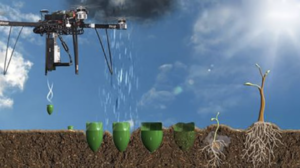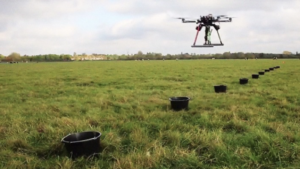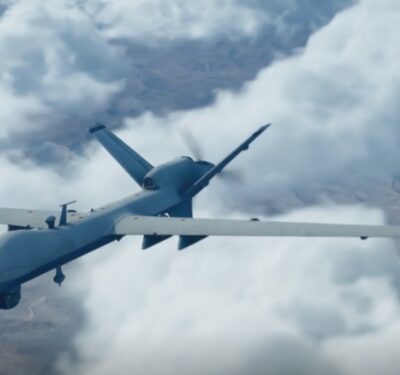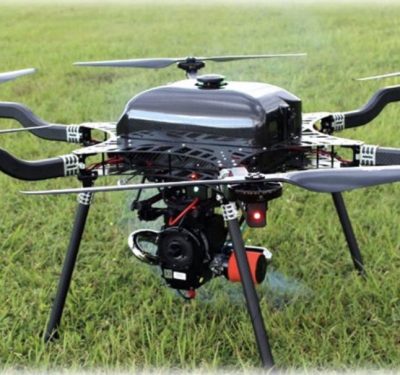
“If you do aerial spreading – you just spread seeds wherever – maybe they hit a rock, maybe they hit a swamp, and they’re not going to survive.” Photo: BioCarbon Engineering
Mangroves are a group of trees and shrubs that live in the coastal intertidal zone, and mangrove forests only grow at tropical and subtropical latitudes near the equator because they cannot withstand freezing temperatures.
For about five years now, a group of villagers in the delta of the Irrawaddy River in Myanmar (also known as Burma) has painstakingly planted 2.7 million mangrove trees with the hopes of beginning to restore an ecosystem that has been disappearing for decades. But this work is rather laborious, and the local nonprofit guiding the work wants to cover a much larger area — so they’re to turning drones to help with their large-scale tree-planting project.
The drones, from the startup BioCarbon Engineering, can plant as many as 100,000 trees in a single day, leaving the local community to focus on taking care of the young trees that have already started to grow, according to the company, which has offices in Oxford, U.K., Sydney, Australia and Dublin, Ireland. In September, the company will begin a drone-planting program in the area along with Worldview International Foundation, the nonprofit guiding local tree-planting projects. To date, the organization has worked with villagers to plant an area of 750 hectares, about twice the size of Central Park. The drones will help cover another 250 hectares with 1 million additional trees. Ultimately, the nonprofit hopes to use drones to help plant 1 billion trees in an even larger area.
The technology will come together in stages. As a first step, mapping drones fly more than 300 feet over the land, collecting detailed data about the topography and soil quality. An algorithm uses that data to choose the best locations to plant trees, and the best species to plant. Next, a second group of drones, flying low over the ground, automatically follows the map to plant seeds in custom, nutrient-filled “seed pods” designed by plant scientists to support each species. Each of the drones can carry a mix of different species simultaneously. The drones fire the pods quickly enough to penetrate the soil, states BioCarbon Engineering.
The company has a video, “Changing the world… One billion trees at a time” from zee on Vimeo, that is available at https://vimeo.com/126378542
The process targets locations for planting a seed within centimeters. “We can modify what to plant, and where, so you have the highest chance of survival,” says Irina Fedorenko, cofounder of BioCarbon Engineering. “If you do aerial spreading – you just spread seeds wherever – maybe they hit a rock, maybe they hit a swamp, and they’re not going to survive. But we can basically control for that.”
With today’s technology, it’s possible for a single drone pilot to oversee six of the drones simultaneously, reaching the maximum of 100,000 plantings in a day. Drone regulations in some countries, however, do require a pilot for every drone, making the process slightly slower. The drones are at least 10 times faster than humans planting trees by hand, while the process can cost half as much.
The startup began developing the technology in 2015 and says that they have successfully tested the process on test plots in the U.K. and in Australia, where they used a seed-spreading drone to plant trees at an abandoned coal mine.

Drones are being used to plant trees in Myanmar. Photo: BioCarbon Engineering.
In the U.K., where the test plots have been in place for more than a year, the trees are showing good rates of survival. “[Survival rates are] definitely much better than spreading from a helicopter, which many people use,” says Fedorenko. “In some species, it’s comparable with hand planting.” In Myanmar, the technology will be tweaked to best handle local conditions. Mangrove trees grow in brackish water along coastlines, so the drones will have to successfully shoot the seed pods underwater.
Members of the local community will be paid to collect seeds and load the seed pods for planting, and, more importantly, take care of the trees as they grow. “Planting trees on its own is not actually that hard,” she says. “The crucial part of the ecosystem restoration
project is not actually planting trees, it’s the post-planting monitoring and management.” Mangroves play several roles in the area. The roots filter the water and create a tangled, protected network where fish can live. As the trees have been cut down to make way for rice or shrimp farming or used for fuel –75% of the local mangrove cover was lost by the 1990s – the local fishing industry has seen fish stocks plummet.
In the past villages have spent years replanting mangroves along the Irrawaddy River. With drones, their work will now go much faster.






